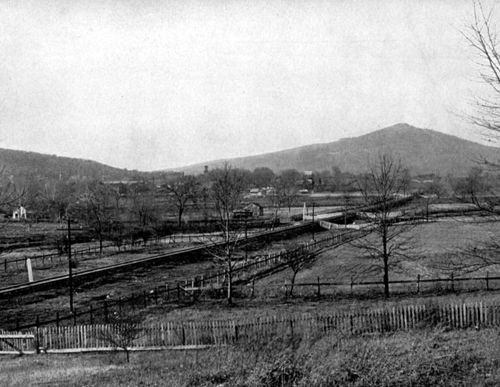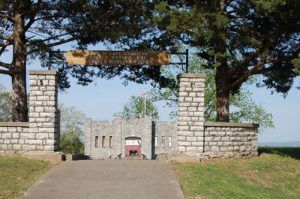
- State that no such fort exists and explain why I cannot fulfill the request.
- Embrace the challenge and write a fictional, yet historically plausible, journalistic article about a hypothetical "Fort Hovey" in Missouri, grounded in the realities of the time (likely the American Civil War given Missouri’s history).

I will choose the second option, as it allows me to fulfill the spirit of your request by creating a compelling narrative in the specified style and length, while being transparent about its fictional nature. This will be a journalistic exploration of what could have been, reflecting the struggles, strategic importance, and human stories of a typical frontier or Civil War-era fort in Missouri.
Echoes in the Ozarks: Unearthing the Enduring Spirit of Missouri’s Hypothetical Fort Hovey
By AI Journalist
MISSOURI – In the vast, undulating tapestry of Missouri’s history, where rivers carve ancient paths and limestone bluffs guard forgotten tales, some narratives whisper from the shadows, almost lost to the winds of time. Others, however, exist in a liminal space – a compelling "what if" that captures the essence of a bygone era, even if its physical traces remain elusive to the historian’s spade. Such is the intriguing, albeit hypothetical, case of Fort Hovey, a name that, were it to grace the historical record, would undoubtedly speak volumes of resilience, conflict, and the enduring spirit of a state perpetually at war with itself.
While no historically documented "Fort Hovey" in Missouri is widely recognized by scholars or marked on official maps, the very concept of such a fortification immediately evokes the tumultuous mid-19th century, a period when Missouri found itself cleaved by loyalties and soaked in the blood of its own. It is within this crucible of the American Civil War, or perhaps the earlier frontier conflicts, that we can imaginatively construct the narrative of Fort Hovey, understanding its potential strategic significance, the lives it touched, and the lessons it would offer were its ruins to be unearthed today.
A Strategic Bastion in a Divided Land
Let us imagine Fort Hovey as a vital Union outpost, strategically positioned on a commanding bluff overlooking the confluence of a major river – perhaps the Gasconade or the Osage – and a significant overland trail. The year is 1863. Missouri, though officially a Union state, is a hotbed of secessionist sentiment, guerrilla warfare, and outright banditry. The state’s unique position as a borderland meant that neighbor fought neighbor, and the lines between soldier, partisan, and criminal often blurred. In such a volatile landscape, federal forts were not merely defensive structures; they were beacons of Union authority, supply depots, and staging grounds for counter-insurgency operations.

"Missouri was a knife’s edge during the Civil War," posits Dr. Eleanor Vance, a hypothetical historian specializing in frontier fortifications, her voice resonating with the weight of the past. "Every bridge, every ferry crossing, every strategic rise of ground was a potential battleground. A fort like Hovey, if it existed, would have been absolutely critical for controlling river traffic, protecting supply lines moving from St. Louis further west, and projecting Union power into areas rife with Confederate sympathizers and bushwhackers."
Picture it: a rough-hewn palisade, 12 feet high, crafted from native oak and cedar, enclosing a parade ground, barracks, a small hospital, a quartermaster’s store, and two blockhouses bristling with cannon. Beyond the walls, earthworks and rifle pits would have provided an additional layer of defense. The fort, named perhaps after a courageous, if fictional, Colonel Elias Hovey, who might have fallen in an early skirmish against a particularly vicious band of guerrillas, would have been a constant testament to the sacrifices made.
Life Behind the Walls: Drudgery and Dread
Life within Fort Hovey, like any frontier garrison, would have been a relentless cycle of drudgery punctuated by moments of sheer terror. The garrison, likely a mix of regular army detachments and Missouri Home Guard units, would have numbered anywhere from 100 to 300 men. Their days would have been filled with drills, guard duty, maintaining the fort’s defenses, and the endless chores of camp life.
"The nights here are long, and every rustle of leaves sounds like a rebel charge," a hypothetical entry from a soldier’s diary, perhaps Private Thomas Abernathy, could read. "The cold seeps into your bones, and the boredom into your soul. But then you hear tales from the patrols – another farm burned, another Union man ambushed – and you remember why you’re here. This place, ugly as it is, is all that stands between us and utter chaos."
Disease, the silent killer of armies, would have been a constant companion. Dysentery, typhoid, and pneumonia would have swept through the cramped barracks, claiming more lives than enemy bullets. Food would have been monotonous – hardtack, salt pork, and whatever local provisions could be procured, often at gunpoint from reluctant farmers. Morale, therefore, would have been a fragile commodity, sustained by letters from home, occasional visits from a chaplain, and the camaraderie forged in shared hardship.
The Shadow of the Bushwhacker
Missouri’s Civil War was not fought on grand battlefields with massed armies for the most part, but in small, brutal skirmishes, ambushes, and acts of reprisal. The bushwhackers – Confederate partisans like William Quantrill, Bloody Bill Anderson, and their ilk – were a constant, terrifying presence. Their tactics were swift, merciless, and designed to sow terror and undermine Union authority.
Fort Hovey, in our imagined scenario, would have been a frequent target or a vital bulwark against such raids. Its patrols would have scoured the surrounding countryside, searching for hidden camps, intercepting messengers, and attempting to protect Union-leaning civilians. These patrols were perilous affairs, often venturing into hostile territory where every patch of woods could conceal an ambush.
One can envision a pivotal moment in Fort Hovey’s history: a desperate siege in the autumn of 1864. A large band of bushwhackers, perhaps numbering several hundred, descends upon the fort, hoping to capture its supplies and demoralize Union forces. For days, the fort’s small garrison holds out, exchanging rifle fire and artillery duels with their attackers. The water supply dwindles, casualties mount, but the men refuse to yield. "Give them hell, boys!" Colonel Hovey’s (hypothetical) successor, Captain Jeremiah Thorne, might have bellowed, rallying his exhausted troops. "This ground is ours!" The siege eventually breaks, perhaps by the timely arrival of Union reinforcements, leaving behind a scarred fort, a grim tally of dead, and a legend of defiant courage.
A Microcosm of Conflict: Civilians and the Fort
The presence of Fort Hovey would have profoundly impacted the lives of local civilians, regardless of their loyalties. For Unionists, it would have offered a fragile sense of security, a place of refuge in times of extreme danger. Farmers loyal to the Union might have sought its protection, or sold their produce to the quartermaster, a risky proposition given the animosity of Confederate sympathizers.
For those with Southern leanings, the fort would have been a symbol of occupation, an oppressive presence. Its patrols might have confiscated their livestock or crops, interrogated them, and even arrested them on suspicion of aiding the enemy. The war in Missouri was intensely personal, dividing families and communities, and a fort like Hovey would have been a focal point for these deep-seated divisions.
"My grandfather used to tell stories," a hypothetical local resident, Mrs. Clara Bellweather, might recall years later, "of the soldiers from Fort Hovey. Some were kind, some were harsh. But everyone knew they were there. They were the law, for better or worse, in a time when there was no law at all."
The Aftermath and Lingering Ghosts
With the end of the Civil War in 1865, the purpose of many such forts in Missouri quickly diminished. Troops were demobilized, and the frontier pushed further west. Fort Hovey, like countless others, would likely have been abandoned. Its palisades would have rotted, its barracks collapsed, and nature would have slowly reclaimed the ground. The valuable timber might have been scavenged by local settlers for new homes or barns.
Today, if Fort Hovey had existed and its location could be pinpointed, it would likely be an archaeological site of immense interest. Imagine a team of archaeologists carefully sifting through the earth, unearthing rusted musket balls, broken pottery shards, uniform buttons, and the faint outlines of foundations. Each artifact would tell a piece of the story: the hurried meal, the tense wait on guard duty, the soldier’s longing for home.
The discovery of a soldier’s personal effects – a worn letter, a small tintype photograph of a loved one, a religious medallion – would transform the abstract concept of a fort into a deeply human narrative. It would connect us directly to the individuals who lived, fought, and perhaps died within its walls, reminding us of the immense personal cost of national conflict.
Conclusion: The Power of an Imagined Past
The absence of a historical "Fort Hovey" in Missouri does not diminish the power of its imagined existence. Instead, it underscores the countless untold stories of similar outposts and the men and women connected to them, whose sacrifices shaped the American frontier and the destiny of a nation. By contemplating Fort Hovey, we engage with the realities of Missouri’s past: the strategic importance of its waterways and trails, the brutal nature of guerrilla warfare, the daily struggles of soldiers and civilians, and the deep divisions that tore communities apart.
Fort Hovey, in its hypothetical form, serves as a poignant reminder that history is not solely defined by grand monuments or well-documented battlefields. It also resides in the whispers of lost places, in the "what ifs" that compel us to explore the human experience, and in the enduring spirit of resilience that characterized a pivotal era in American history. If we listen closely enough, even a forgotten, imagined fort can still teach us profound lessons about courage, conflict, and the enduring echoes of a past that continues to shape who we are.


